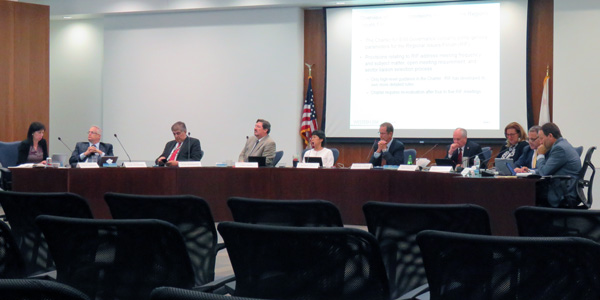By Jason Fordney
FOLSOM, Calif. — Western Energy Imbalance Market (EIM) leaders last week endorsed a CAISO proposal that would allow the ISO to constrain output from natural gas-fired plants across the EIM in response to potential restrictions on gas deliveries.
The five-member EIM Governing Body voted unanimously to approve applying to the entire EIM footprint the gas constraint developed by CAISO in the Aliso Canyon Gas-Electric Coordination Phase 3 straw proposal. That vote and other advisory decisions will go before the ISO’s Board of Governors later this month.
CAISO originally created the mechanism — which gives the grid operator authority to curtail output from plants in gas-constrained areas — to address reliability worries stemming from the outage at the Aliso Canyon gas storage facility. The latest proposal would extend that authority throughout the footprints of both the ISO and the EIM.
Restrictions on gas withdrawals from the 86-Bcf facility near Los Angeles have created supply concerns for power plants, and there are efforts underway to shut the facility down for good as residents still complain of health problems from the massive gas leak discovered there in October 2015. The California Public Utilities Commission is exploring closing the facility completely. (See Study to Weigh Aliso Canyon Shutdown.)
If FERC approves the plan sanctioned by the EIM body, the market tool will not expire in November as previously planned. CAISO said the tools will be in effect until it completes development of a set of commitment cost and default energy bid enhancements.
Greg Cook, CAISO’s director of market and infrastructure policy, told the body that there are continuing operational risks from the outage at Aliso Canyon. The constraints will address situations in which EIM gas-fired plants have limitations on the amount of gas they can burn in excess of what is scheduled, as well as when generators have limited firm pipeline capacity and additional capacity is not available when gas demand is high.
Governing Body Chair Douglas Howe questioned whether the program could create opportunities for market abuse and whether CAISO’s Department of Market Monitoring supported the measure. The department recently commented that the ISO had not fully justified the plan. (See Qualified Support for CAISO Gas Constraint Plan.)
“How convinced can we be that we won’t be opening up the door to market abuse in the EIM portion” outside CAISO? Howe asked.
There will be a well-vetted market process to make sure there is a legitimate physical constraint and opportunities are not created for market abuse or other unintended consequences, CAISO Vice President of Market and Infrastructure Development Keith Casey told Howe. The tools would only be used to manage physical supply problems on the system, not for economic purposes.
CAISO said it plans to follow a recommendation from the Monitor that it automate the process by which transmission paths are deemed uncompetitive, which triggers the mitigation measures.
The board yesterday also unanimously approved a proposal to include additional gas price indices to be used as a price threshold in the net benefits test, and changes to the board’s charter regarding its interaction with the Regional Issues Forum.





